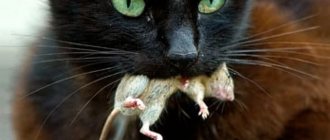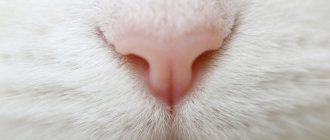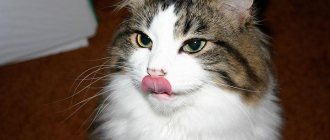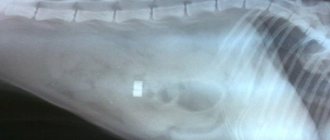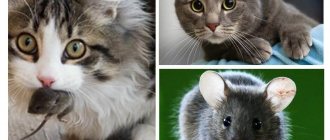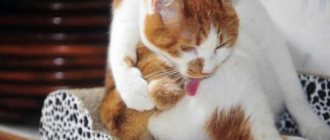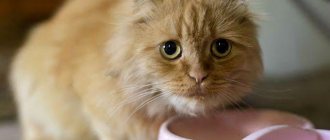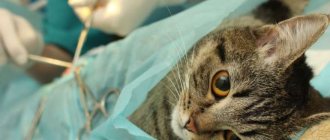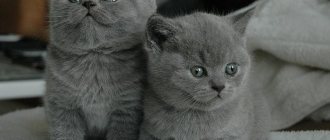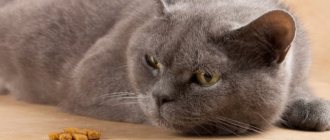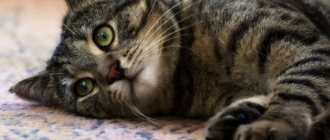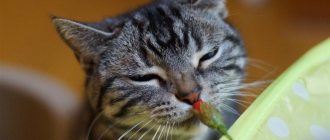Laces are attractive little things for pets to play with. The owner's inattention often leads to the ingestion of these inedible objects. Threads, rain and ropes are dangerous because they reach the gastrointestinal tract and roll into clubs, blocking the passage. It doesn't always help. If changes in health are noted, if the cat ate the rope, the doctor decides what to do.
Is it dangerous if a cat eats threads?
Thus, if the tip of a thread or, for example, a Christmas tree “rain” gets into the cat’s mouth, it can swallow up to several meters of its length. This can cause intestinal blockage and is therefore very dangerous for the animal.
What to do if you find that a cat has eaten threads? Provided that the animal feels normal, you can try to help it at home. If the thread was recently swallowed by the cat, you can try to induce vomiting. To do this, salt water is poured into the animal’s mouth - at the rate of 2 teaspoons of salt per liter of liquid.
If some time has already passed since the threads were swallowed, they have probably reached the cat's intestines. In this case, a little Vaseline oil is poured into the cat's mouth through a syringe. It will facilitate the passage of a foreign body through the animal’s intestines. In this case, it is better not to feed the cat for some time. When the threads begin to come out naturally, do not pull on them under any circumstances! This is deadly for the animal because it can injure the insides of the cat. You can only cut off the end of the thread sticking out from under the tail.
Symptoms, diagnosis
Manifestations depend on the length of the swallowed lace. If the cut is small, it comes out naturally without any problems. If you get hit by a long rope, your health worsens. This happens immediately or after 2-3 days, a week. Sometimes the signs don't appear at all.
Alarming symptoms:
- loss of appetite, refusal of water;
- constant nausea, vomiting;
- problems with stool (diarrhea, constipation);
- pain in the abdominal area;
- expectoration, frequent swallowing;
- apathy and immobility.
If these symptoms are detected, you need to take the cat to the clinic. For diagnostic purposes, the veterinarian will examine and palpate the abdomen, perform x-rays with and without contrast, and gastroscopy. Then he will decide on the method of extraction.
How dangerous?
Cats are famous for their curiosity, so they can often swallow objects that are not intended for food. Pets often end up with laces, New Year's rain, and threads in their mouths. On the tongue of pets there are so-called hard villi; their direction does not allow the cat to spit out the thing that has entered the oral cavity, so the animal has to swallow it. Even if the tip of a thread is in the mouth, the pet can swallow it whole, up to several meters. If a cat has eaten rope or dental floss, the problem should not be ignored. Eating such items can cause intestinal blockage and even lead to death.
What should the owner do?
When the owner catches the pet eating threads, it is important not to hesitate. First of all, you will need to take the cat in such a way that it cannot resist and scratch the person. Then the pet needs to open its mouth and carefully remove the thread if it remains on the tongue. However, the owner may not have time. If the cat has already swallowed a foreign object and no serious deterioration in its condition has been noticed, it is permissible to provide first aid at home. When a pet ate a thread not long ago, the first thing the owner needs to do is try to provoke vomiting. Veterinarians recommend preparing a saline solution. To do this, you will need to add 2 teaspoons of salt to 1 liter of purified water and mix thoroughly. The resulting composition must be poured into the cat’s mouth and wait until he vomits.
If the pet ate threads a few hours ago, they should have already reached the intestines. In such a situation, you should use a syringe without a needle and Vaseline oil. A product is carefully poured into the animal’s oral cavity, which helps facilitate the passage of threads through the gastrointestinal tract. After the manipulation, veterinarians recommend not giving the cat food for 2-3 hours. In addition, the owner needs to make sure that the pet goes to the toilet. When the threads begin to come out of the anus, the owner is strictly forbidden to try to pull them out. This precaution is due to the fact that the possibility of damage to internal organs cannot be excluded.
To prevent the threads from disturbing the cat, they are carefully cut off.
A pet that has swallowed thread does not always feel well. The following symptoms may be noticed:
- apathy;
- weakness;
- vomit;
- anxiety.
If your pet has a piece of rope visible from his mouth
He hasn’t swallowed it yet, you can slowly pull it. Do not pull too hard, as you can damage internal organs. The rope has already entered the stomach; you should be very careful not to scratch the animal’s mucous membrane during removal. If you manage to get a foreign object, it is worth organizing a gentle diet for several days and giving the cat a soothing remedy for the stomach, for example, chamomile decoction 5 ml 3-4 times a day.
How to remove a thread that has not been completely swallowed
If a cat eats a thread and the owner manages to notice it, the pet needs to be helped immediately. The animal itself will not be able to spit out the object due to the structure of its tongue, the roughness of which prevents anything from falling out of the oral cavity. Therefore, if you catch a cat eating thread, you need to intervene and carry out the following actions :
- Take the animal so that it does not resist and, if possible, does not harm the owner.
- Force open the cat's mouth.
- Using your fingers, carefully remove the thread if it remains on the tongue.
In such a situation, the owner is forbidden to hesitate, since cats swallow inedible things at the same speed as regular food.
What to do if you couldn’t remove the thread
More often it happens that pets swallow the thread, and the owner does not have time to monitor it. This can be dangerous for the cat, especially if the thread is thick, long or stiff. Often, the entry of such a foreign object into the animal’s body causes vomiting.
If several minutes have passed and the cat has not vomited, the owner should help and induce a gag reflex in him. To do this, it is recommended to pour water and salt into your pet’s mouth at the rate of: 1 tsp. salt per 1 liter of liquid. There is no need to pour all the water into the animal, just wait for the necessary reaction. There should also be an ill-fated swallowed thread in the vomit.
What is the danger
Seeing the thread, the cat immediately remembers his childhood, the piece of paper on the thread and the fun of fussing with it. Therefore, not a single cat will pass by such an interesting item. At risk are young animals, kittens and pets left to their own devices for a long time. Young animals, due to lack of experience or for fun, can swallow a needle, thread, buttons, snaps and other small objects.
The structure of a cat's tongue. Furry pets, unfortunately, very often swallow sharp objects and, as a rule, this leads to their death. The problem is not that the cat is stupid and cannot “spit out” an inedible, dangerous object. The structure of a cat's tongue is such that a thread that gets into the mouth can only be swallowed.
The tongue has hard tubercles directed towards the esophagus. As it turned out, the tips of the tubercles have a U-shaped structure. With this “fork” the animal rips meat off the bones of its prey and takes care of its coat. A pet can only swallow a thread caught in these “flyers”, otherwise it is impossible to get rid of it. And along with the thread, the needle is sent into the esophagus.
Consequences and risks
The needle can pierce the stomach, intestines and damage other organs adjacent to them, or penetrate muscle tissue. Various options for passing a sharp object are fraught with:
- perforation of the digestive tract;
- development of erosion, ulcers, neoplasms;
- tissue necrosis;
- internal bleeding;
- peritonitis;
- mucosal injury followed by inflammation;
- dehydration as a result of vomiting and diarrhea;
- exhaustion due to refusal of food, intestinal obstruction;
- damage to internal organs.
Even if the needle is very “successfully” located in the body and does not cause any disturbance to the animal, after a while it will begin to oxidize under the influence of biological fluids and digestive juices.
Metal oxides can cause purulent melting of tissues and blood poisoning.
Signs of internal damage
If a cat swallows a sewing needle, it may exhibit symptoms characteristic of gastrointestinal injuries:
- loud meowing and rubbing of the face;
- apathy, lying motionless in one place;
- refusal of food and water;
- profuse drooling;
- nausea and vomiting, possibly with traces of blood;
- hiccups or belching;
- bloody streaks in the stool;
- constipation, flatulence, bloating.
If the needle is stuck in the throat, palate or esophagus, the cat strains its neck, often swallows, coughs, and wheezes. Don't worry if your cat behaves normally, doesn't show anxiety, and there are no signs of damage.
Source
What to do if your cat feels bad
If the cat has eaten the thread, it does not come out, and the pet’s health worsens, he becomes lethargic and refuses to eat, you need to contact a veterinarian, as the situation becomes dangerous.
When examining a cat, the doctor will give recommendations and determine the next steps to save the animal. The owner, in turn, needs to tell the veterinarian how long the pet’s condition has been worsening since he ate the thread.
In mild cases, the doctor can solve the problem on the same day by using an endoscope to free the insides of the cat’s body.
What to do if your cat ate a needle and thread
The most dangerous situation is when a cat swallows a needle and thread, since the risk of damage to the intestines and other insides of the animal from the needle tip increases significantly. Such cases require the owner and pet to immediately contact a doctor for surgery.
Surgical intervention is not considered difficult and in most cases cats tolerate it well. It is aimed at removing thread and needle from the pet’s body.
The postoperative period requires care for the cat, but passes quickly.
If a pet has eaten a thread, the owner needs to act decisively to save it. And for the future, it is recommended to remove from the animal’s field of vision all foreign objects that could cause harm to the cat.
Removal by operation
From the intestines
When intestinal obstruction is confirmed by radiographic and ultrasound methods, the surgeon, as a rule, decides to perform diagnostic laparoscopy. During the operation, the foreign body is removed and the intussusception is reduced. If necessary (in cases of necrosis), part of the intestine is resected.
To learn how to remove a foreign object from a cat’s intestines using enterotomy, watch this video:
From the stomach
In rare cases, it is possible to remove a foreign object from the stomach using diagnostic gastroscopy. If a foreign body is detected in the stomach of a domestic cat using endoscopic, x-ray or ultrasound examination, the surgeon usually decides to perform a gastrotomy.
Removal of threads from the stomach during gastrotomy
Having gained immediate access, the stomach is held in place using ligatures. The foreign body is removed using instruments or palpation. After suturing the mucous membrane and muscle layers, the organ is returned to its anatomical location. The operation is performed under general anesthesia.
From the esophagus
If the location of the foreign body is the esophagus, in some situations it is possible to remove it using an endoscope. If the object is large, the surgeon can perform an esophagotomy. The operation is indicated if the x-ray shows perforation of the walls of the esophagus, or the foreign body is large and has sharp edges.
Often the veterinarian resorts to the following manipulation. Using an endoscope, an object is pushed into the stomach, after which the animal undergoes a gastrotomy, followed by removal of the foreign body.
Penetration of a foreign body into the digestive canal of a pet is a dangerous phenomenon for health and life. The animal must be urgently taken to a specialized facility for special diagnostic procedures to visualize the swallowed item. As a rule, treatment comes down to surgical removal of the foreign body by laparoscopy, gastrotomy or esophagotomy, depending on its location.
